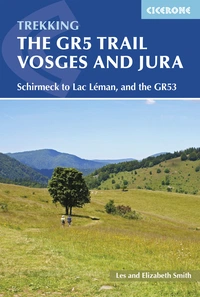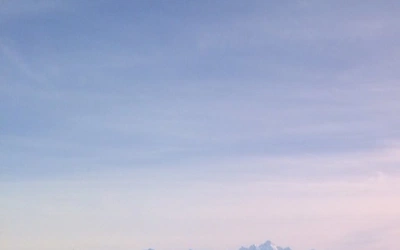Flowers of the Jura Mountains
Switzerland’s Jura Mountains are a stunning, year-round location to explore away from the main mountainous and touristy areas of the Alps. In this article by Ali Rowsell, author of Switzerland's Jura Crest Trail, you will find an introduction to one of the main highlights of the mountain range: wildflowers, in all their beauty.
The Jura Mountains form a 360km-long sub-alpine range of ancient folded strata along the border between Switzerland and France. Extending from the Rhine Valley in the north-east to the Rhône Valley in the south-west, the undulating range is a rolling showcase of natural features, including extensive alpine pastures, tranquil forests, craggy, exposed cliffs, deep gorges, mountain streams and glistening mountain lakes.
The Jura Mountains are a haven for wildflowers and are home to more than 950 flowering plant species due to the rock type, well-drained soils, microclimates and localised environmental conditions. The Jura is made up of limestone, a sedimentary rock that offers the perfect growing conditions for a wide variety of flowering plants; in particular, the slopes and plateaus of the Jura from between 1000m and 1700m, where the grazing pastures are opened up to cattle in the summer and covered with snow in the winter. These areas suffer from relatively little agricultural chemical change, leaving natural meadows where a variety of species will flourish.
Wildflowers such as crocus and spring gentians appear as early as March and later-flowering species wilt away as late as October.
The best months to see the alpine meadows in their full beauty is between June and early August, when a range of colours scatter the hillsides, leaving scents of perfume lingering, which can be tasted in the local Alpine cheeses of the region.
Wildflowers are extensive throughout the whole Jura mountain range, while the southern Jura offers museums, local history, distilleries and fromageries where you can learn even more about the flowering species.
Le Pont, Vaud, is a great base to start an exploration of wildflowers and their use in local delicacies. The hiking trails on this section of the Jura (Stages 11-14 of the Jura Crest Trail) offer wide-ranging opportunities, from exploring craggy limestone escarpments to extensive alpine pastures. Local cheese can be sampled at fromageries and alpages in the area around the Vallée de Joux, such as the Fruitières de Nyon and the Musée du Vacherin Mont-d'Or in Les Charbonières. The museum also offers a wealth of information about distilling yellow gentian roots to make a liqueur, sipped as a digestif following fondue.
Flowers are not only important for pollinating, feeding insects, birds and animals, or simply for their beauty; they provide an extraordinary existence for the people of the Jura Mountains.
Some of the wildflowers characteristic of the Swiss Jura include:
Yellow gentian (Gentiana lutea) is abundant in the Jura region and farmed and distilled in the Vallée de Joux to make a botanical liqueur drunk as a digestif. These giant flowers grow up to 1m in height and live for up to 50 years. Liqueur is made with gentian roots that are over 10 years old.
White hellebore (Veratum album) is a toxic plant that is a member of the lily family, not to be confused with the yellow gentian. The leaves of hellebore alternate, while the gentian leaves sit in pairs. The hellebore grows to a similar height to the gentian, although it has whiter flowers.
Eyebright (Euphrasia officinalis) is a low-growing parasitic plant with white asymetric flowers, found in Alpine pastures and grasslands. I regard them as fried-egg plants due to small yellow markings in the centre of the flowers – a great way for children to become involved!
Monk’s-hood (Aconitum variegatum), also known as wolfsbane, is a highly toxic plant with blue-violet flowers, found in mountainous terrain and rockier parts of the Jura. The plant has asymmetric flowers and grows up to 150cm in height. Legend has it that growing wolfsbane will fend off wolves from the area.
Field gentian (Gentianella campestris) is found in most alpine meadows, pastures and forest clearings throughout the Jura and is identifiable by its four large blue-violet petals with a central corolla. The field gentian has a long flowering season, from March to October.
Edelweiss (Leontopodium alpinum) is a quite rare sight in the Jura and generally found in high alpine pastures, on rocky outcrops or inaccessible areas. Edelweiss is covered in dense, fine hairs and noticeable from afar due to its silver appearance. Edelweiss is strictly protected and should not be picked.
Harebell (Campanula rotundifolia) is a hardy and tolerant singular blue-violet nodding flower that is a member of the campanula ‘bell’ family, growing to about 50cm in height. Harebells are fairly common, flowering between March and September.
Grass of Parnassus (Parnassia palustris) is a stunning, freely arranged plant distinguished by its white flowers, with distinctive clusters of yellow stamens at the centre. Notable by its five petals and translucent green stripes atop long stems with dark green heart-shaped leaves, this flower is found throughout Europe, but especially in alpine regions.
Bladder campion (Silene vulgaris) is a flower with a pink bladder-like bulge and white petals clumped together in five bunches; its leaves are used throughout the Mediterranean in various food dishes such as gazpacho and omelettes.
Alpine pasqueflower (Pulsatilla alpine) is a toxic plant bearing white-yellow flowers early in the season and distinctive seed heads atop hairy, textured stems later in the year. The plant grows to around 20cm in height and is very distinguishable in the later months when pastures of wiry seed-heads can be found blowing in meadows.
Field scabious (Knautia arvensis) is a tall, hairy flower with blue-violet to pink anthers consisting of four unequal petal lobes that attracts butterflies, bees and insects. Its flowering season is long, from March to October, and they are found throughout Europe.
Carline thistle (Carlina vulgaris) is found on dry alpine pastures and identifiable by its clusters of spiky, brown-golden flower heads, not too unlike a thistle. Carline thistles generally indicate poor soil and legend has it that the flower head prevents bad luck or ill health!
Rosebay willow herb (Chamerion angustifolium) is a colonising plant also known as ‘bombweed’ or ‘fireweed’ after it sprouted up in wasteland following World War I and World War II bombings throughout Europe. A single fireweed can produce 80,000 seeds.
Greater masterwort (Astrantia major) is a member of the carrot family with a tall (up to 40cm in height), hollow singular stem bearing an umbellifer head of flowers, which are very popular with butterflies. The freely arranged flowers are out from June to August.
Plume knapweed (Centaurea uniflore), also known as singleflower knapweed, is easily recognisable by the straight stem covered with short, rough hair and grey-green leaves of less than 1cm, and a pineapple bud under the thistle-like flowering head.
Protected areas
Throughout the Jura, there are several nature reserves and protected areas, identified by localised signage. These are in place to protect flowers and wildlife of the area, therefore should be respected. You should not pick any wildflowers, as they are unlikely to survive outside their natural habitat. Some flowers, such as edelweiss, are protected throughout the Alps and it is an offence to pick them.
The Cicerone guidebook Switzerland's Jura Crest Trail provides more information about the Jura Mountain range, including wildflowers, when to visit, local walks and the Swiss national number 5 long-distance hiking route, the Jura Crest Trail.
Gillian Price’s Alpine Flowers (Cicerone) is also a useful reference book.












